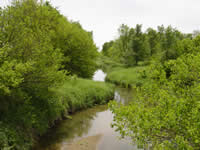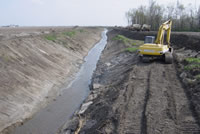Drainage in Illinois: Time for a New Approach
 Before reading any further, briefly
consider the differences between these two photos taken from the exact
same view point on the Spoon River. What you might not know is that what
happened on the Spoon in April 2005 could also happen on a river near
you.
Before reading any further, briefly
consider the differences between these two photos taken from the exact
same view point on the Spoon River. What you might not know is that what
happened on the Spoon in April 2005 could also happen on a river near
you.
Illinois' thousands of miles of rivers and streams wind through forests,
urban areas, high limestone bluffs and lowlands.  For
many, home and community are defined by the rivers they live on or near;
rivers they fish or paddle; and rivers where they go to watch birds and
other wildlife that make their home along their banks.
For
many, home and community are defined by the rivers they live on or near;
rivers they fish or paddle; and rivers where they go to watch birds and
other wildlife that make their home along their banks.
Rivers and streams have also played an integral part in shaping Illinois' agricultural economy. For the first settlers, they offered a form of natural drainage for lands that were often inundated with water. Later, as human-built agricultural drainage systems were put into place, rivers and streams were enlarged, deepened and straightened to achieve the goal of quick, high capacity field drainage.
In the late 1800's, when agricultural drainage systems were first built, however, there was no expectation or requirement to consider how stream channelization might impact riparian ecosystems. Like many other industries, however, agriculture has undergone tremendous changes in knowledge, technology and practice. Changes have, at times, resulted from the fact that those practices degraded or harmed natural ecosystems. For example, the invention of tillage equipment that turns over a smaller amount of soil, and an increased popularity in "no till" practices, have reduced soil erosion and its resulting environmental impacts. Buffer strips have been promoted along agricultural fields to trap sediment, fertilizers, pesticides, and bacterial pathogens that would otherwise enter the rivers and streams adjacent to fields.
Today, almost 2000 drainage districts in Illinois continue to dredge, channelize, and clear cut along Illinois' rivers. Like the problems caused by tilling and runoff, the negative environmental effects of agricultural stream channelization on river ecosystems have been recognized by state agencies, county soil and water conservation districts, and other experts. In 2001, the Department of Natural Resources issued a report entitled "Critical Trends in Illinois Ecosystems." With respect to the conditions of the state's rivers, the report concluded that most Illinois streams had only fair to poor habitat quality and species diversity. Those river basins that ranked the worst in habitat typically were basins where:
- agriculture was the predominant land use
- streams had been channelized
- streams lacked natural habitat features such as wooded riparian corridors.
A 1997 University of Illinois Extension report entitled 60 Ways Farmers Can Protect Surface Water summed up the problem when it said "Channelization seemed like a good idea at the time," but "channelization often makes things worse in the long run," and is "an idea whose time has gone." The report recommends letting streams follow their normal path.
Yet, unlike changes in tilling practices and the development of buffer strip, few steps have been taken to promote and implement newer drainage practices to minimize disturbance of riparian ecosystems. Instead, traditional practices largely remain the norm and rivers are routinely stripped of their vegetation and channelized, causing habitat loss for fish and wildlife. The pictures shown above were taken at the exact same spot on the Spoon River in Champaign County and vividly illustrate the dramatic impacts that drainage maintenance activities performed in April of 2005 have had on the river.
In a state where 70% of the land is used for growing crops, adequate drainage is essential for crop success and for the health of the state’s agricultural economy. However, equally important is ensuring that the other economic and environmental benefits of those rivers and streams that co-exist with agricultural lands are not lost.
Prairie Rivers Network believes it's time for a new approach to drainage maintenance that balances all river functions and protects the environment as the drainage code requires. To that end, and with the support of the Lumpkin Family Foundation, we have written "A Citizen's Guide to Illinois' Agricultural Drainage Practices and Law" for individuals who want to learn more about the practices, policies, and law regarding agricultural drainage in Illinois and ensure that providing adequate drainage is not done at the expensive of maintaining river ecosystem health.
After you have read it, we encourage you to learn more about your local drainage district and to get involved in decision that may affect the health of your local river. Working together, we can achieve a new, environmentally sensitive approach to drainage in Illinois.
References
Following are links to all the reference materials we have related to this project.Reports
"A Citizen's Guide to Illinois' Agricultural Drainage Practices and Law"
Press Releases
March 19, 2004 Judge rules river is merely a ditch March 1, 2004 Hearing Set for Dredging on Upper Salt Fork River Prairie Rivers to Serve as Friend of the Court December 30, 2003 Environmental Interests Given Voice in Drainage Project Decision November 17, 2003 Group seeks to protect public resources on Salt Fork River October 8, 2003 Citizens want more protection for water and wildlife September 4, 2003 Antiquated Drainage Practices Are Ill-Advised July 1, 2003 Local Government Taxing Body Plans Work that Hampers Salt Fork Fish Kill Recovery
Special Reports
February 2, 2004 Upper Salt Fork River serves many purposes August 21, 2003 Public Perceptions of Water Quality in Illinois by the Illinois Natural History Survey